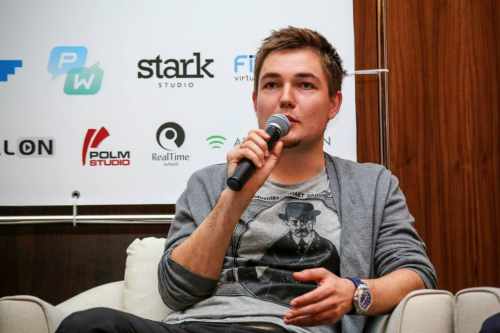As part of the Mobio Talks program, Alexey Pisarevsky, the founder of the Mobio agency, interviewed Maxim Donskikh, the president of Game Insight. We publish a transcript of the material.
Alexey Pisarevsky: Game Insight needs no introduction, tell us a little about yourself: how did you get into the company, and what was your path to the president.
Maxim Donskikh: I got into game development a long time ago. He started in the IT Territory company, which was engaged in the development of browser games and succeeded in this more than others. You can only compare [her success] with “Fight Club”. Then Astrum Online Entertainment holding was formed on its basis. There I was engaged in the casual direction, we were one of the first to launch games for social networks in Russia. With many like-minded colleagues, we then found ourselves in Game Insight.
And then what happened?
Game Insight was formed as a result of the merger of several studios, one of which was led by me. It was called Road 404 and made, for example, “Airport City” — one of the biggest hits of Game Insight.
We set up the work so that everyone could do many different things for the benefit of other studios and Game Insight in general. For example, in addition to managing the studio, I was engaged in publishing, then marketing. Well, in the end he became president.

How easy were these movements for you? For sure, what you are doing today as president is very different from what you did as a marketing director.
Now it seems that everything was logical and easy, although every time it was a leap into the unknown. In fact, there was only one job in all positions — to make the games come out and be successful. I solved this problem from the point of view of both development and marketing. Only the scale and degree of influence on the tasks changed.
You have a lot of experience in game development. Name the gold standard of the development studio: what it should consist of, what departments, what mandatory competencies should be in the team, what you can’t do without.
The gold standard of development has not changed in recent decades. To make a game, programmers, game designers and artists are needed. It will be good if there is still a carrier of the idea of the game who would push it. It is very good if he will be the owner of the studio or at least be motivated to death for financial success. Then there are more chances that the game will work out.
But if we’re talking about the frituplay games that Game Insight deals with, then it’s not enough to just make a game. The most important thing begins after the release — at the stage of operation, when the audience came. This audience should be entertained with constant updates, new content, features, events. All this should come out with a certain frequency so that the players do not run away, come back.
To build such an architecture, we need people with special knowledge. Already at the development stage, it is important to work out how the game will develop in the future — both from the point of view of technology and from the point of view of game design.
In addition, the operation is associated with a huge number of numbers, which was practically not before in the gaming industry. This is a constant removal of metrics from the audience: what the user does, how he plays. Accordingly, we need those who collect and process these figures. It can be game designers, producers, analysts – it doesn’t matter. It is important that they should be in the team.
And, of course, nowhere without marketing.
Here [all this] is the modern gold standard. The team turns out to be a decent size.
You said that programmers, game designers and artists are needed. Let’s say these guys gathered in such an indie team, as they are called. Do they have a chance of success in modern realities?
Of course, they have a chance. Exactly the same as everyone else’s — not very big.
You need to immediately decide that indie games, due to the fact that they are made by small teams, most often live on a different business model. Small teams cannot ensure a long and systematic development of a free-play product, so they go the other way: they make paid games or free ones that are monetized on advertising. This is a slightly different niche, but, yes, there are some chances.
Speaking of indie, I would divide the teams into two categories. There are developers who are burning with an idea, have given up everything for it, invest their money in its implementation and self-realization. This is respected regardless of the commercial result.
Another category of indie is small teams that, for some reason, have got together, but are trying to make a business out of it: they think which game the market will accept better, where what niche is, where to get through. This is not much different from the usual commercial development, but the scale is smaller.
Of course, there are examples of success, because indies often try new genres, ideas. This is very positive for the market.
That is, there are positive examples from the series “a new genre was invented and went-flew”?
There are, but it can rarely be put on stream. It’s good if you managed to make a hit, and then you need to like in a casino — you took the money home. It is very rare to reproduce your success, because every time it is a new experiment, and it does not happen that every experiment succeeds. Small teams can most often survive only one setback. It is much easier for a large company in this regard: there is a financial cushion and the opportunity, even after unsuccessful releases, to continue working, release new games and grope for new success.
And what should an indie team do in this case, if they did it and it turned out, they earned money? As I understand it, there are two ways: you can wait for a conditional Game Insight to buy you, or you can try to grow a team, develop.
Almost everyone chooses the way to develop [further], but it is important to be aware of this: this is already a commercial enterprise, and it operates according to other laws. As a result, it really turns out to repeat the success of the units.

Everything is clear with Indy. Tell me a little about marketing, you’ve been doing a lot of it. Obviously, today and three years ago are completely different things. What has changed in the market?
Three or four years ago, marketing was done by eye, very roughly estimating the correlation of the efforts made and the result obtained in terms of installations and ultimately money. There was little transparency, tools, analytics. As a result, some cargo cults have formed, how to launch or promote games: put them in tops at the start, buy some articles, branding on portals. Once it gave a result, once it didn’t. Why? It wasn’t easy to figure out. At the same time, in our case, traffic is the blood of business, new users are constantly needed. So the further we went, the more difficult the tools for attracting them became. It was necessary to understand what was happening, where the user came from, what he was doing inside the game. Analytics were being pushed further and further, and purchases were already being optimized for some specific goals, and not just “let’s drive the game to the top, we’ll have a bunch of organics, and that’s it, we’re in chocolate.” This is from the general changes.
Obviously, everything has become more expensive. Competition is growing, and everyone understands that business does not work without a constant influx of new players. Budgets are increasing cumulatively across the industry, so an individual user is becoming more expensive. This leads to the fact that no one is interested in buying just users anymore. Because for this money (no longer small compared to the amounts that were 3-4 years ago), everyone wants to get some specific user, with a specific profile and, preferably, very preferably, paying.
Looking at the conditional Machine Zone, it seems that everything is fine with them. They still buy everything. Do they measure everything so well, or do they have everything so cool automated, or is the LTV so high that they can afford it? Or just don’t count the money?
And yes, and yes, and yes. And everything is cool, and LTV is high, and money does not count. It is difficult for our companies to compare themselves with Machine Zone or Supercell, they play a completely different game. Firstly, in investment, respectively, in a constant increase in turnover. Ultimately, the stake in their game is a kind of dominance in the market and in the genre. If you have achieved this, then no matter how much it cost, you already receive benefits from the first place. Many people try to live in such a model, but only a few succeed.
Not everyone has enough money?
The stakes are really high and, since so many companies are competing, it is no longer enough just to have a large LTV, money or a good team of marketers. There should be one, and the second, and the third and 10 more points on top.

What does a grid or an agency, a conditional traffic provider, need to do today to work with gaming companies? It’s no secret that they are the most advanced mobile app developers on the market. Everyone knows how, they like to do it themselves, they count well. What should such guys do?
It’s a good question, I’ve been asked it many times. I have asked it to agencies many times myself: “And why do we need you?”. And no one could answer me. It’s no secret that gaming companies are good at making purchases on their own, this is primarily due to the fact that the UA must be very tightly integrated into the operation. It is necessary to react very quickly to all changes within the game: promotions, changes in user behavior, and so on. It is difficult for a third-party agency to get involved in this. In addition, gaming companies are very scrupulous about their data and do not like to share them. And without them, traffic providers cannot be optimized for specific KPIs and goals that buyers face.
If you still answer the question “How can agencies be useful?”, then these are most likely some very narrow segments of services that are difficult or expensive for developers and publishers to master on the go. One example is traffic in Asia, which is very difficult to work with from Europe, and to work with which you need either a presence in the Asian region or local partners.
Tell us more about Asia. China, Korea, Japan — these countries are very interesting for any game developer. What’s going on there, how are you doing?
This is the situation with Asia. If you look at the gaming market as a pie, then Asia’s share in it is constantly increasing. Japan and Korea are the most profitable regions in mobile games. China is also growing strongly, although until recently it was believed that no one pays there. At the same time, it is not easy to work with them, because the audience is very specific both in terms of its closeness as a market and in terms of player preferences.

Developers from Europe and the United States, like Game Insight, still have the American and European markets dominating in revenue. Only a few manage to make their way to Asia so that it is a significant part of the income. Everyone aspires there, but there are a lot of obstacles. In the meantime, it is much more noticeable that Asians are entering the European and American markets.
But it’s hard for them too.
If we are talking, for example, about Chinese games, then they can afford to have a thousand people in development and do everything possible inside this game in terms of features and amount of content. This leads to the fact that their local players expect the same from all games. The same applies to other Asian markets. If we are talking about Japan and Korea, then there events in games should be included several times a day. There is a much more measured rhythm in Europe or the States. Therefore, when a European or American game reaches an Asian audience, some Japanese or Korean is 10 times faster than the developers expected, passes it and swallows all the content, and then sits down and waits. He won’t wait long, and then he’ll go back to his Puzzle & Dragons.
What about other markets? As far as I know, you recently had experience in Turkey, you actively promoted the games. Why Turkey?
We chose Turkey for the soft launch of our Guns of Boom shooter for several reasons. Firstly, shooters are played there, and secondly, the game was launched on Android, and there is a large share of Android. Thirdly, it is quite inexpensive to attract an audience there.

After all, softlonch. You didn’t plan to earn much there?
We plan to make money there and are making money, but, roughly speaking, after the world release, in any case, the situation will change, and the main markets will still be America and Europe.
Is everything really bad with Russia? No chance to earn money here? Does it make sense to release games only for Russia?
I don’t see the point in that. Game Insight hasn’t been doing this for a long time. This can only be justified by some unknown reasons, for example, if you are making a farm about “Prostokvashino”. But, other things being equal, why limit your audience to Russia? Yes, it is easier to work with it and, in general, you can start with it, but why count and build a business on the Russian audience for a gaming company? Mobile stores, compared to the previous gaming era, have opened up a global market for developers. That is, you made a game, uploaded it to the store, ticked where you want to open it, and here are all your players — America, Europe, Asia, whatever, including Russia. And this is a global change in the game market, because before you were developing some game for 1C money, and then you had to launch it in each region separately, it was very expensive and difficult. Therefore, then – yes, it made sense to launch only on Russia.
What do you think about prospects on some individual platforms? iOS and Android are clear. Have you tried to make social networks on the desktop, is Steam growing any more?
It’s good everywhere. We have tried a lot of things for ourselves, now the focus of Game Insight is games for mobile platforms. Before that, we focused very closely on games for social networks.
When choosing a platform, first of all, you need to evaluate whether it is suitable for your game. It’s stupid to ignore new platforms if they are suitable for technology and for the audience that can be found there. Therefore, if it turns out, you need to try everything, there are prospects everywhere.

What is missing from the game development market? What are you waiting for in a few years? What will appear?
I’m waiting for new ways to distribute games, new channels. Because all platforms and channels go through, albeit at different times, approximately the same path. A new platform or channel appears, and the first ones who get there break the bank. Then there is growth, with the growth of the market, competition increases, and over time it becomes more and more difficult to find your user. Game Insight has already managed to be on this wave twice. At first it was social networks, a completely new sphere. Then we were one of the first to switch to mobile platforms. And I would say that I am waiting for such a new leap, where we will be able to rebuild again and bring new games to new users. Maybe it will be VR, maybe messenger games — we’ll see. In any case, it will be interesting.
